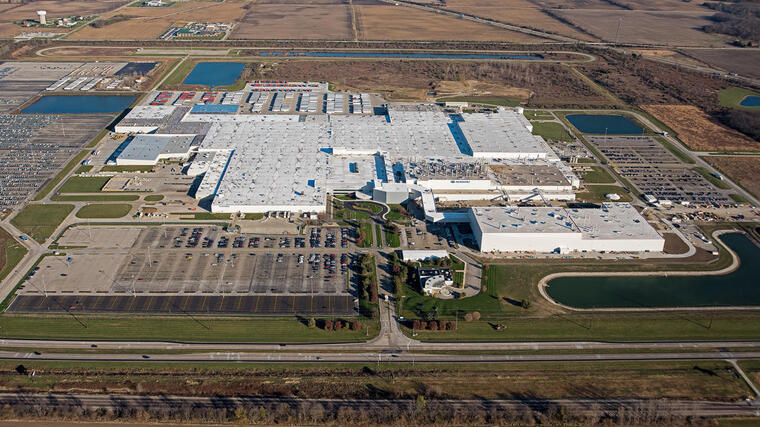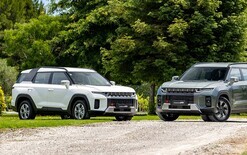Tariffs ‘make car trade more difficult’

Market analysts are predicting Detroit’s “Big Three” car manufacturers will be more exposed to Donald Trump’s tariffs on automotive imports than prominent Japanese and German rivals.
While the 25 per cent levy has been applied broadly as part of the president's new trade policy intended to boost domestic brands, some American marques are set to be impacted negatively.
General Motors, Ford and Stellantis, which is the parent group of Jeep, Dodge, Ram and Chrysler, are particularly vulnerable, according to market analysis by Jato Dynamics, an automotive intelligence company based in the UK.
The three manufacturers collectively sold about 1.85 million imported cars in the US during 2024, or 13 per cent of their combined global sales.
In comparison, Toyota, Honda and Nissan – the three largest Japanese brands – sold 17.9m units worldwide last year. Of this total, 1.53m were imported and sold in the US, equating to nine per cent.
For Germany’s Volkswagen Group, Mercedes-Benz and the BMW Group, American demand for their imports accounted for only seven per cent of their combined global aggregate.
“With a smaller global presence than some Japanese and European counterparts, US manufacturers rely heavily on domestic sales, meaning that tariffs on cars imported largely from Mexico, Canada and South Korea will be felt keenly,” states a Jato Dynamics’ report.
A 25 per cent import tariff on all US car imports was confirmed by Trump on his self-proclaimed “Liberation Day” last week.
The imposition of tariffs on global imports has sent the automotive industry into a frenzy over the past seven days.
The likes of VW are holding cars at American ports and Jaguar Land Rover (JLR) has paused deliveries to the US, while rival Ineos Automotive is hiking the price of its Grenadier in the US by five per cent.
The UK’s prime minister, Sir Keir Starmer, has diluted his government’s EV sales targets in the lead-up to 2030’s ban on sales of new petrol and diesel cars, while Trump’s levies are a threat to an estimated 25,000 British jobs.
In the US last week, Stellantis announced it will furlough 900 workers and pause production in multiple factories as it works through its tariff response.
Ford, which had a higher-than-average stock of vehicles, is offering employee discounts to customers, and GM will ramp up US-based production of its top-of-the-range pick-ups.
Trump’s decision to levy tariffs on imports comes at a time of heightened issues for the car industry. Other factors include falling demand for foreign vehicles in China, and stifled growth and regulatory pressures in Europe.
Felipe Munoz, global analyst at Jato Dynamics, says: “The US is the world’s second-largest market. It will now be more difficult for the vast majority of non-Chinese automakers around the world to trade.”
About 16.1m new light vehicles were sold in the US in 2024. Around 6.3m were largely imported from Mexico, Canada, the EU, UK, Japan and South Korea, all of which will face a 25 per cent tariff when exporting to the US.
From May 3, these measures will be broadened to include automotive parts produced outside the country, presenting another headache for American and non-US brands.
“Few will benefit from the imposed tariffs, but some brands will suffer more than others,” warns Jato Dynamics. For example, Mazda, Subaru and GM are most reliant on imports into the US, reports ThisIsMoney.co.uk.
Mazda sold 1.28m new cars globally in 2024 with some 343,000 imported and sold in the US.
The country also accounted for 71 per cent of Subaru’s total car sales last year. While a large portion of the its vehicles were produced at its factory in Indiana, pictured, imports into the States still made up one-quarter of its total volume globally.
GM is also highly dependent on the US market. It ranks just behind Hyundai and Kia, and Toyota, in total vehicle imports in 2024. GM’s global footprint is largely concentrated in North and South America, China and a few smaller markets.
Sales of imports into the US made up 18 per cent of is total global sales – the highest percentage among the world’s five largest automakers.
As for luxury brands, McLaren, Bentley, Aston Martin and Rolls-Royce have among the highest total percentage of global sales delivered to the US. However, experts predict any price increases imposed are likely to be swallowed by their customers.
Upping output in the US?
Jato Dynamics’ report also examines which car companies will need to have a sizeable strategy change due to their reliance on the American market.
Among them is the Volkswagen Group. In 2024, the Americas made up less than 10 per cent of its global sales. As a result, the German manufacturer, alongside Honda, is less exposed than other major carmakers.
That said, this level of protection will be offset by the fact vehicles made overseas account for around 80 per cent of its sales in the US.
Munoz adds: “The US is a vital market to 14 of the 18 non-Chinese global carmakers. For the likes of VW, the US contributes a relatively small amount of the brand’s total revenue, but it will seek to hold a presence to retain its position as a global brand.”
Alongside Volkswagen, other brands are also likely to need to increase their production footprint in America in the near future. They include Volvo, Hyundai, Kia, Mercedes-Benz, BMW, Stellantis, Toyota, Nissan, Subaru and GM because “the US is a market they can’t leave”.





